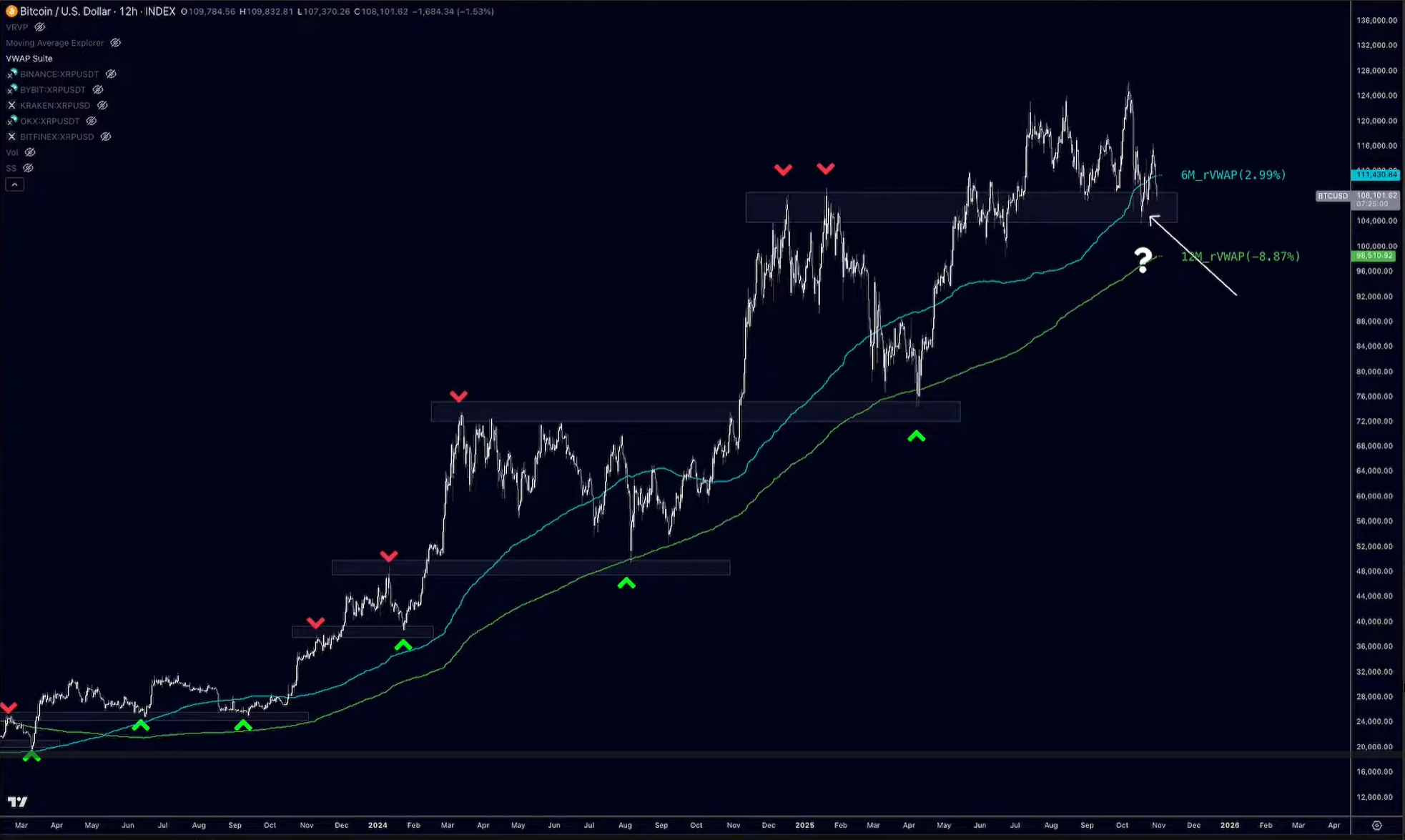Bitcoin is sitting on the first true make-or-break support of the cycle, and the market is currently in what cryptocurrency analyst Dom (@traderview2) calls a “fork in the road.” His message is direct. Unless Bitcoin stabilizes and recovers key levels quickly, the structure that defined this entire move will collapse for the first time, sending it to the downside.
“This is Bitcoin’s last chance to sustain these levels and move higher,” he said in a live analysis stream on Oct. 29. “If Bitcoin can’t get a foothold here over the next week or two, I think this will break down and we’ll see the mid to low $90,000s again.”
Last resistance to Bitcoin’s stair rise
Dom’s basic case is not a classic cryptocurrency winter. He does not predict an 80% wipeout. Instead, he warned that the coming days will determine whether Bitcoin can maintain the “staircase” structure that has supported the cycle thus far. Even if it collapses, he expects a controlled but sustained recovery – not a collapse, but not a continuation either.
“I don’t think we’re going to go into a year-and-a-half bear market like we’ve seen so far,” he said. “Those are things of the past…unless the world falls into a severe recession like the Great Depression.”
The key line for Bitcoin that he focuses on is the area around $111,000 to $114,000, which he mentioned in the context of restored resistance and the VWAP level. “If it doesn’t recover in a short period of time, I think we need to prepare for an even bigger collapse, in which case it would be less than $100,000,” he said. The first target in his breakdown is around $98,500, which coincides with what he calls a 12-month rolling VWAP, or “bull market band for the entire cycle.”

Under this, he is considering whether buyers will actively intervene. The response, he says, will determine whether the $95,000 is a local wipeout and reset or the start of something much worse.
The reason he considers this moment a “do-or-die” moment is because unlike earlier in the cycle, Bitcoin is no longer immediately rebounding from support. According to Dom, Bitcoin has followed a single, clear pattern throughout its ascent: breaking a major resistance level, retesting it once, and then rallying higher and exploding. “Whenever we eliminated resistance, we held it as support,” he said. “It was a perfect pattern throughout the cycle.”
That behavior has now changed. After the October 10 liquidation event and brief strength around the Fed decision and China headlines, Bitcoin stalled. It broke through resistance, but has since remained there for “four or five months,” unable to expand, and is now losing momentum at exactly the same levels that buyers had previously defended so nervously.
“There are people who don’t believe this is a discount,” he says. “There were so many bounces for the same price, but buyers aren’t interested at all. What’s going to interest them? The logical thing to do is lower the price.”
This is classic auction theory for him. In a strong uptrend, the first retest of a major level is bought immediately because participants see it as cheap. Right now, he says, order flow is showing hesitance rather than urgency. This is how tops are actually formed in cryptocurrencies. Not a dramatic candlestick, but a refusal of buyers to defend the same level five times.
He also directly pointed out the shallow liquidity of major physical books. Regarding Coinbase, he said, “These order books are empty…no one is going to save us here.” “That’s only 170 Bitcoins. That’s not really that much,” he said, explaining only the thin passive bid interest of nearly $100,000 and the intense aggressive selling pressure on Binance. “People are aggressively pushing the market… and we don’t have anyone on the other side who can absorb that pressure.” His conclusion is that this is exactly the setup you would do before making a fast air move if the key level breaks.
That vulnerability is not hypothetical. Dom said the October 10 crash has already proven how dependent cryptocurrencies still are on a small number of market makers. “We basically went through an empty order book,” he said. “This proves how fragile cryptocurrencies really are. If their risk system says, ‘Hey, I’m not going to quote this,’ the market will crash just like they did.”
80% no crash this time
Still, Dom is not in a position where “the cycle is over forever.” He believes that markets have changed structurally and that most traders are still using 2021 mental models in 2025 markets.
He argues that Bitcoin is now an institutional vehicle rather than a purely speculative retail vehicle. “We’ve had a very steady step-like growth here,” he said. “The difference is…this was really driven by financial institutions. I think financial institutions were the main driving force behind this cycle…ETFs were launched and we’re kind of moving up the ladder.”
This slow and controlled progress is why he rejects the idea that Bitcoin will repeat the classic -80% drawdown after reaching the top. He calls this new trend “park money.” That’s money from ETFs, corporate treasuries, allocators, and “$401,000 in funds from financial advisors,” not actively panic selling on every 5% move. “They don’t call you every other day and say, ‘Oh, it’s down 5%. Let’s sell,'” he says.
He also pointed out that instead of rising vertically, this cycle barely doubled its all-time high and even made a new high before the halving. In his view, if the upside is suppressed and systematic, the downside is also likely to be suppressed and institutionalized.
At the time of writing, BTC was trading at $110,280.
Featured image created with DALL.E, chart on TradingView.com










